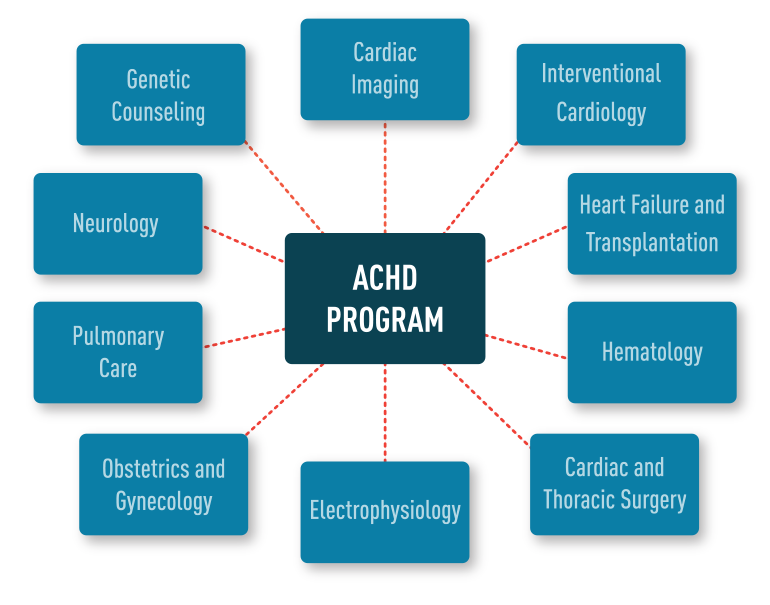Longitudinal Approach to Adult Congenital Heart Disease Care
In This Article
- Approximately 40,000 children are born with a congenital heart defect (CHD) every year in the United States. In 2010, more than two million people in the US were living with the condition
- With new treatments and increased survivorship, the population of people with CHD is aging, and it is now estimated that more adults have CHD than children
- Adults with CHD can have a broad range of medical problems, and treating them requires multidisciplinary, longitudinal care
Approximately 40,000 children are born with a congenital heart defect (CHD) every year in the United States. In 2010, more than two million people in the US were living with the condition. With new treatments and increased survivorship, the population of people with CHD is aging, and it is now estimated that more adults have CHD than children. The number of hospital admissions for adult congenital heart disease (ACHD) is also increasing.
Subscribe to the latest updates from Cardiovascular Advances in Motion

Fig. 1: A Multidisciplinary Approach to Treating CHD
Comprehensive longitudinal care of patients with congenital heart disease within the Heart Center involves multiple medical subspecialties and includes the patient, family and community caregivers to create leading-edge, state-of-the-art care.
Adults with CHD can have a broad range of medical problems, and treating them requires multidisciplinary, longitudinal care, says Ami Bhatt, MD, director of the Massachusetts General Hospital Adult Congenital Heart Disease Program. The program, one of the oldest and largest longitudinal care programs in the country, provides truly comprehensive care for ACHD patients (fig. 1).
When intervention and treatment are required, ACHD patients can meet with specialists from multiple clinical disciplines. Interventional treatment options are varied and include cutting edge advances and trials in percutaneous valve procedures and hybrid OR procedures. Patients can also participate in medical trials, such as RUBATO (a trial for single ventricle patients). For aortic aneurysms, surgical treatment options are offered across the age range and disease spectrum. Resynchronization therapy, mechanical assist devices, hospital and home heart failure management programs and heart as well as heart-lung and heart-liver transplant evaluation are integral to the program.
The Mass General program recognizes the importance of identifying patients before interventions are necessary, and continuing longitudinal care after any procedures take place. It partners with community health programs and tertiary care providers to find at-risk adults and provide education and risk assessment. Through telemedicine programs, it delivers cardiac care to its patients outside the hospital walls and genetic counseling as well as high risk obstetric and anesthesia support is available for patients considering pregnancy.
As the population ages, preventive cardiology is a focus, ensuring that patients and their families control atherosclerotic disease risk factors and decrease coronary artery disease and stroke risk. Health and wellness are specifically emphasized by nursing led programs centered on weight reduction, exercise prescription in conjunction with the cardiac performance program and stress reduction.
The longitudinal approach allows Dr. Bhatt and her team to follow children through to adulthood, monitoring their course of treatment and any complications that may arise as they mature. This not only informs future decisions for the individual patient, but also guides treatment for younger patients with the same or similar issues.
Developing Treatment Algorithms
As Dr. Bhatt and her team monitor these patients, they work closely with a team of cardiac surgeons to make decisions about interventions. Deciding when to intervene is vital, says Mass General cardiothoracic surgeon Duke Cameron, MD. “When caring for adults with CHD it is important to minimize the number of interventions that need to happen and to perform the correct intervention at the correct time.”
For example, only a small subset of patients with anomalous aortic origin of the coronary artery (AAOCA), a rare condition where both coronary arteries arise from the same aortic sinus, require surgery. Dr. Doreen DeFaria is leading a longitudinal study of about 259 patients with AAOCA being cared for at Mass General over 40 years. Using a treatment algorithm and management strategy, including anatomic- and function-based surveillance, the team is able to select at-risk patients in need of surgical intervention.
Dr. Bhatt’s goal is to use the advances they’ve made in the ACHD Program—in basic science and genetics, physiology and engineering with colleagues at MIT, and imaging and treatment—in order to better predict, and eventually completely avoid, the complications that accompany lifelong CHD. “We want to apply a level of scientific rigor to treating patients with CHD,” Dr. Bhatt says. “This hasn’t happened in the past because we didn’t have the knowledge or the numbers.” But that is changing.
“This is the next chapter in the story about successful treatment of congenital heart disease,” adds Dr. Cameron.
Refer a patient to the Corrigan Minehan Heart Center
Learn more about Mass General’s Adult Congenital Heart Disease Program